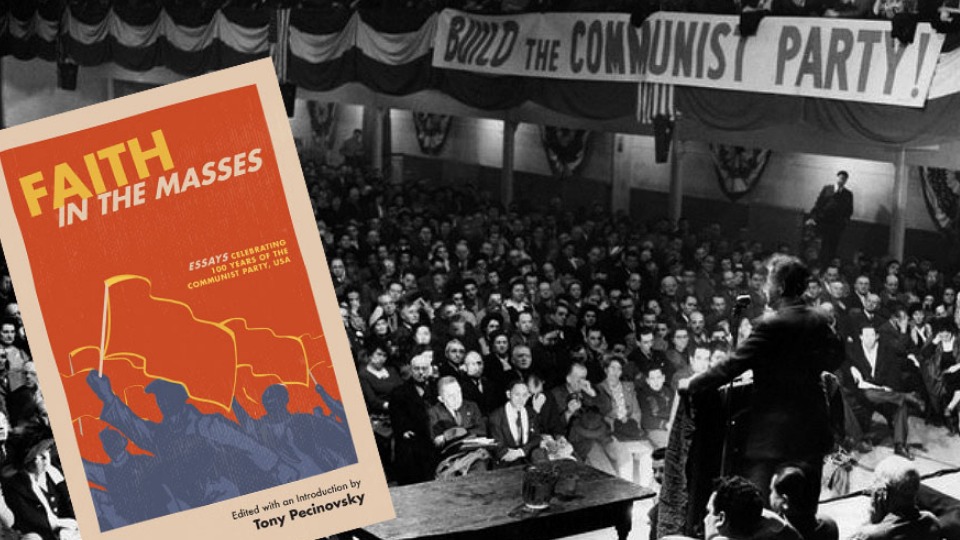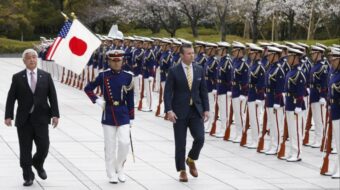
Faith in the Masses: Essays Celebrating 100 Years of the Communist Party, USA, edited by Tony Pecinovsky, is an ambitious undertaking—almost as ambitious as the work the book describes. These essays cast a wide net aiming to capture the breadth of the Party’s efforts to change society over the last century. The celebration is heartfelt, reverent at times, hyper-romantic at others, and decidedly not uncritical.
The collection of short pieces is itself one manifestation of faith about which there is much to like. The very first contribution is Norman Markowitz and Tony Pecinovsky’s outline of Party history, providing a framework helping the reader to understand how the organization responded over the decades to the critical problems of American society and government. Their brush is detailed as well as encompassing. Real people respond in organized fashion to the issues of their time. Of particular interest is how the Party responded to various internal missteps along the way, to the almost ceaseless red-baiting attacks from outside, and to the winds of change involving race and gender questions.
Once set, the structure of this collection is embellished by a dozen topical chapters, a bit unevenly sewn together, but cohering by the force of their telling and the historical import of their subjects. C.J. Atkins’s gracefully written, well organized recounting of the often overlooked life of Party founder Charles Emil Ruthenberg, who, alas, died all too young, at 44, in 1927, is a true gem that stands as a metaphor for the Party itself: hard, selfless work to make a difference in the world of its time.
Centerpieces of the Party’s struggle—the labor movement, civil rights, and electoral politics—follow the models of historical overview and origins tales. Joshua Morris’s “Playing by Our Own Rules: The Communist Party’s Presidential Campaign in 1932” well lays out the promise and perils of participation in “bourgeois” electoral politics. Timothy V Johnson’s “The Communist Party and the African American Question” traces the rocky path toward defining a politics of the Black “nation” in large part informed by widespread discussions within the international Communist movement in the 1920s and 1930s over colonialism.
In “‘Has White Supremacy Ended Your Pain’: Beulah Richardson and Art in the Struggle Against Racism” by Denise Lynn, and “The Cartoons of Ollie Harrington, the Black Left, and the African American Press During the Jim Crow Era” by Rachel Rubin and James Smethurst, the authors explore the development of political line and actual struggle in the Communist Party’s vital, central role at the intersection of class and race through powerful examples of cultural expression that were perilously on the precipice of being forgotten. It is made clear in these essays that though the current term “intersectionality” may be new, the CP had arrived at the exact same analysis decades before (the work of Claudia Jones among others comes to mind).
Again on the issue of race, People’s World writer Al Neal, who covers the sports beat for the paper, contributes a fascinating piece, “‘First to Start the Fight’: Communism, the Daily Worker, and Baseball.” Neal reminds us that the CP in its early days remained highly skeptical of sports as a topic even worth covering in its Party press, being an unhealthy diversion of workers’ attention from the class struggle. But he shows how gradually that attitude changed, and the Party, with writers such as Lester Rodney passionately following the unfolding story, became one of the leading lights, with the African-American press, in the national struggle to integrate baseball and other sports.
Labor issues suffuse the collection of essays. Robert Zecker’s “‘Faith in the Masses’: The International Workers Order” tells the story of that worker-run and Party-led mutual insurance and benefits society that fell victim to the axe of McCarthyism in the early 1950s. Long before the New Deal, the IWO, and the Workmen’s Circle before it, along with many other, mostly ethnic fraternal societies, created critical networks of social support addressing functions that in better organized welfare states the government addressed. This raises a glaring question to place before conservatives, even today. If they want to “get government off our backs,” why then do they attack people and their homegrown organizations for self-help?
Other references to workers’ issues run like rich veins begging to be mined. But among the core tenets of Party history and values, the labor movement itself is given short shrift, as noted in the Introduction for good reason. By now labor’s oft-told stories are otherwise accessible, through the work of scholars like Philip Foner et al and biographies of labor leaders, organizers, and workers—many of these also available from International Publishers. Still, it would have been of greater value for less familiar younger generations, and even those knowledgeable, to include more extensive coverage of working-class struggles alongside the kindred topics.
Read a preview chapter from the book: Gus Hall and the Communist campus tour of 1962
There are fascinating pieces on feminism (Elizabeth Armstrong’s “Gita, Betty, and the Women’s International Democratic Federation: An Internationalist Love Story,” which recalls activists Gita Bannerji of India and Betty Millard of the CPUSA); on literature (Joel Wendland-Liu’s enlightening “A Culture of Human Liberation: U.S. Communist Writers in the 20th Century”); and the environment (Marc Brodine and Tony Pecinovsky’s “Virginia Brodine: Deciphering and Communicating the Science of Environmental Sustainability”).
Topicality notwithstanding, one of the most forward-looking essays is Pecinovsky’s chapter “Far from Marginal: The CPUSA in the 1960s and early 1970s,” recounting the energetic bounce back from McCarthyite persecution. The Party had built new organizational outlets and conducted speaking tours, particularly on campuses, throughout these years, well engaging itself in the tumult of the times, including the Free Speech Movement, Civil Rights, and anti-war movements. One only hopes the space given to this chapter did not shut out another voice or topic, because much of this material was also covered in the author’s 2019 book Let Them Tremble: Biographical Interventions Marking 100 Years of the Communist Party, USA.
Although this chapter only contracts to deal with Party activity into the 1970s, here would certainly seem to be a place to continue and expand Markowitz and Pecinovsky’s earlier outline of Party history. The fifty years that have elapsed since the seventies, particularly in the aftermath of organizational splits, demand more thorough updated exploration—perhaps in a follow-up volume if it’s not too soon for historians to dredge up some uncomfortable incidents in the recent past involving persons very much still with us.
Yet as the question of marginality is raised, it is not unfair to shine a light on the more recent Party work, national and local, individual and organizational. Historic struggles in civil rights, peace, anti-apartheid, labor, environmental, and other movements have grown through direct action participation, from the fight to preserve public education to the Dakota Pipeline to the Black Lives Matter marches and anti-gentrification, housing, and anti-white supremacist demonstrations, not to mention some history-making electoral campaigns.
Faith in the Masses shows clear signs of having been rushed into print for the centennial of the Party. Too many are the typographical and grammatical errors, misspellings (both Nakita Khrushchev and Pete Seager on p. 39), incomplete bibliographical data, and repetition of common mistakes such as “International [rather than Industrial] Workers of the World (p. 99 and again on p. 129), that needlessly distract the reader and unfortunately detract from the overall confidence in this book as a source. It deserved better. Hopefully, many of these can be cleaned up in a second printing.
Most laudable is the inclusion of a number of essayists whose names had been unfamiliar, at least to this reader. There seems to be a whole industry now of scholars committed to studying the history of the CPUSA and setting the record straight not only on its accomplishments but on its earnest grappling with problems the larger society was not paying heed to.
Let’s continue this inspiring story in classrooms, on picket lines, and in the streets!
Faith in the Masses: Essays Celebrating 100 Years of the Communist Party, USA
Ed., Tony Pecinovsky
New York: International Publishers, 2020
425 pp. with illustrations, $19.99
ISBN 10: 0-7178-0829-7
Order here: Faith in the Masses










